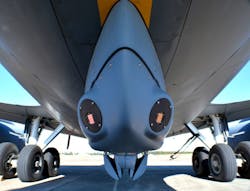Northrop Grumman to install LAIRCM laser missile defense systems aboard U.S. large military aircraft
PATUXENT RIVER NAS, Md. – Missile-defense experts at Northrop Grumman Corp. will install LAIRCM laser-based missile-defense systems for large military aircraft under terms of a $123.5 million U.S. Navy order announced on Friday.
Officials of the Naval Air Systems Command at Patuxent River Naval Air Station, Md., are asking engineers at the Northrop Grumman Mission Systems segment in Rolling Meadows, Ill., to provide the electro-optical Large Aircraft Infrared Counter Measures (LAIRCM) for a variety of U.S. military aircraft.
LAIRCM automatically detects a missile launch, determines if it is a threat, and activates a high-intensity laser-based countermeasure system to track and defeat the missile, Northrop Grumman officials say.
The system is for large aircraft like the U.S. Navy P-8A Poseidon maritime patrol jet and the Marine Corps CH-53 Super Stallion large helicopter. LAIRCM also can go aboard the U.S. Air Force C-5, C-17, C-37, and C-40 cargo and utility jets; C-130H and MC-130W four-engine utility turboprop aircraft, the CV-22 tiltrotor aircraft, and the KC-46 aerial refueling jet.
Northrop Grumman will provide necessary hardware, systems engineering, technical support, analysis, and studies to integrate the LAIRCM aircraft missile-defense system onto aircraft for the U.S. Navy, Army, Air Force, and the governments of Norway and New Zealand.
For the Navy, hardware for this procurement includes 418 advanced threat warning (ATW) sensors, 272 high capacity cards (HCCs), 160 PCMCIA cards, 64 Guardian laser transmitter assemblies (GLTAs), 64 GLTA shipping containers, 48 control indicator unit replaceable (CIURs), 14 smart connector assemblies (SCAs) and six multi-role electro-optical end-to-end test sets (MEONs).
For the Army, hardware includes 156 HCCs, 138 ATW sensors, and 23 CIURs. For Air Force equipment includes 64 PCMCIA cards and 45 ATW sensors. Norway will get six GLTAs, six GLTA shipping containers, six SCAs, and four HCCs. New Zealand will get 30 Infrared Missile Warning Sensors, five GLTAs, five GLTA shipping containers, five SCAs, three HCCs, two CIURs, and two MEONs.
LAIRCM focuses its high-intensity laser energy at the infrared seeker head of incoming missiles to blind the missile and force it off its target. The system is designed to protect large aircraft from shoulder-fired, vehicle-launched, and other infrared-guided missiles when the planes are operating close to the ground, such as during takeoffs, landings, and low-level operations like aerial refueling.
Initial LAIRCM systems equipped C-17 and C-130 aircraft as a stop-gap measure, using an ultraviolet sensor, a countermeasure processor, and a small laser turret assembly.
Later-model LAIRCM systems use a smaller laser turret, and operate in the infrared region. Compared to first-phase LAIRCM systems, the newer models provide better resolution, better performance in optical clutter, and increased range of detection.
Related: Northrop Grumman moves to next phase of DARPA laser weapons-based missile-defense program
In the future military leaders are trying to develop aircraft-protection infrared countermeasures able to detect and classify incoming missiles, then emit a custom jamming energy to defeat them.
On this order Northrop Grumman will do the work in Rolling Meadows, Ill.; Goleta and Carlsbad, Calif.; Longmont and Boulder, Colo.; Blacksburg, Va.; Lewisburg, Tenn.; Apopka, Fla.; and other U.S. locations, and should be finished by July 2022.
For more information contact Northrop Grumman Mission Systems online at www.northropgrumman.com, or Naval Air Systems Command at www.navair.navy.mil.
